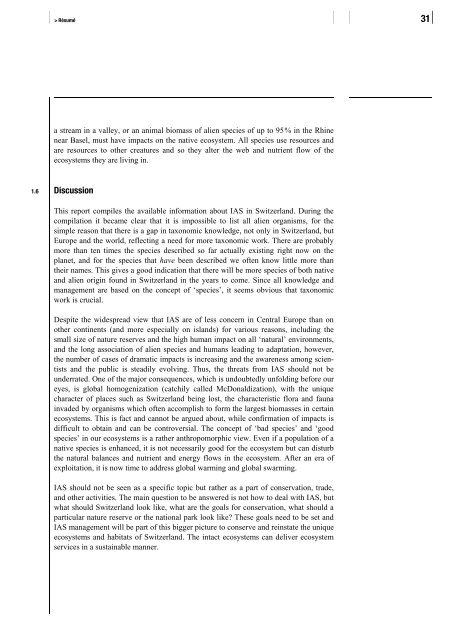Invasive alien species in Switzerland - Schweizer ...
Invasive alien species in Switzerland - Schweizer ...
Invasive alien species in Switzerland - Schweizer ...
You also want an ePaper? Increase the reach of your titles
YUMPU automatically turns print PDFs into web optimized ePapers that Google loves.
Résumé 31<br />
a stream <strong>in</strong> a valley, or an animal biomass of <strong>alien</strong> <strong>species</strong> of up to 95 % <strong>in</strong> the Rh<strong>in</strong>e<br />
near Basel, must have impacts on the native ecosystem. All <strong>species</strong> use resources and<br />
are resources to other creatures and so they alter the web and nutrient flow of the<br />
ecosystems they are liv<strong>in</strong>g <strong>in</strong>.<br />
1.6 Discussion<br />
This report compiles the available <strong>in</strong>formation about IAS <strong>in</strong> <strong>Switzerland</strong>. Dur<strong>in</strong>g the<br />
compilation it became clear that it is impossible to list all <strong>alien</strong> organisms, for the<br />
simple reason that there is a gap <strong>in</strong> taxonomic knowledge, not only <strong>in</strong> <strong>Switzerland</strong>, but<br />
Europe and the world, reflect<strong>in</strong>g a need for more taxonomic work. There are probably<br />
more than ten times the <strong>species</strong> described so far actually exist<strong>in</strong>g right now on the<br />
planet, and for the <strong>species</strong> that have been described we often know little more than<br />
their names. This gives a good <strong>in</strong>dication that there will be more <strong>species</strong> of both native<br />
and <strong>alien</strong> orig<strong>in</strong> found <strong>in</strong> <strong>Switzerland</strong> <strong>in</strong> the years to come. S<strong>in</strong>ce all knowledge and<br />
management are based on the concept of ‘<strong>species</strong>’, it seems obvious that taxonomic<br />
work is crucial.<br />
Despite the widespread view that IAS are of less concern <strong>in</strong> Central Europe than on<br />
other cont<strong>in</strong>ents (and more especially on islands) for various reasons, <strong>in</strong>clud<strong>in</strong>g the<br />
small size of nature reserves and the high human impact on all ‘natural’ environments,<br />
and the long association of <strong>alien</strong> <strong>species</strong> and humans lead<strong>in</strong>g to adaptation, however,<br />
the number of cases of dramatic impacts is <strong>in</strong>creas<strong>in</strong>g and the awareness among scientists<br />
and the public is steadily evolv<strong>in</strong>g. Thus, the threats from IAS should not be<br />
underrated. One of the major consequences, which is undoubtedly unfold<strong>in</strong>g before our<br />
eyes, is global homogenization (catchily called McDonaldization), with the unique<br />
character of places such as <strong>Switzerland</strong> be<strong>in</strong>g lost, the characteristic flora and fauna<br />
<strong>in</strong>vaded by organisms which often accomplish to form the largest biomasses <strong>in</strong> certa<strong>in</strong><br />
ecosystems. This is fact and cannot be argued about, while confirmation of impacts is<br />
difficult to obta<strong>in</strong> and can be controversial. The concept of ‘bad <strong>species</strong>’ and ‘good<br />
<strong>species</strong>’ <strong>in</strong> our ecosystems is a rather anthropomorphic view. Even if a population of a<br />
native <strong>species</strong> is enhanced, it is not necessarily good for the ecosystem but can disturb<br />
the natural balances and nutrient and energy flows <strong>in</strong> the ecosystem. After an era of<br />
exploitation, it is now time to address global warm<strong>in</strong>g and global swarm<strong>in</strong>g.<br />
IAS should not be seen as a specific topic but rather as a part of conservation, trade,<br />
and other activities. The ma<strong>in</strong> question to be answered is not how to deal with IAS, but<br />
what should <strong>Switzerland</strong> look like, what are the goals for conservation, what should a<br />
particular nature reserve or the national park look like? These goals need to be set and<br />
IAS management will be part of this bigger picture to conserve and re<strong>in</strong>state the unique<br />
ecosystems and habitats of <strong>Switzerland</strong>. The <strong>in</strong>tact ecosystems can deliver ecosystem<br />
services <strong>in</strong> a susta<strong>in</strong>able manner.
















